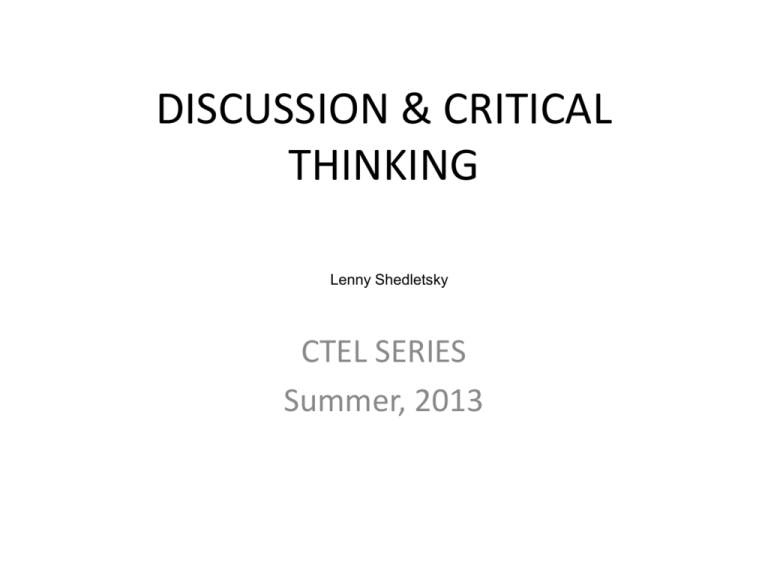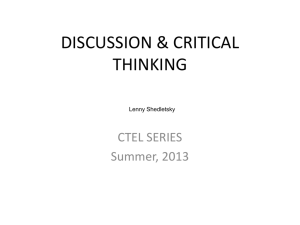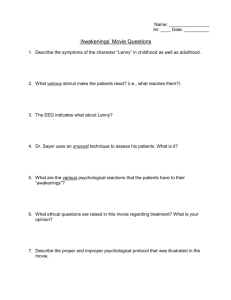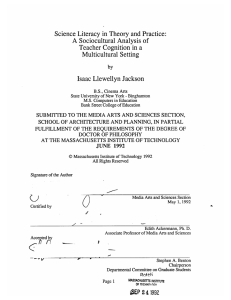DISCUSSION & CRITICAL THINKING
advertisement

DISCUSSION & CRITICAL THINKING Lenny Shedletsky CTEL SERIES Summer, 2013 MY BIAS, MY HUNCH: THESE ARE NOT BEST PRACTICES • These are ‘trying my best’ practices; • I need you to help me figure out what would be best practices; LIST OF RULES FOR DISCUSSIONCREATED BY MY CLASS Here is our list based on our discussion last night. We can change the list as we go along. Please comment on the list as you see fit. [see http://media.usm.maine.edu/~lenny/group_rules.htm] • • • • • • • • • • • • • • Be respectful; Be open minded; Be authentic; Disagree well; Be prepared; Attack the theory, not the person; Don't interrupt to disagree; Comment on what is presented; Don't be vague--be specific in responding; Do not dominate the discussion; Don't use your cell phone or computer during class if it's not for the class work; Don't break up into two-somes or three-somes--stay together as a group; We do not need to raise hands; Have the group set some goals within each discussion topic so we can expand upon them and meet the goals together; THE TEACHER STRUGGLES TO GET DISCUSSION GOING DIFFERENT TYPES OF DISCUSSION • VARIATIONS ON DISCUSSION • Probing Questions • Motivated Reasoning INTRODUCING ADOBE CONNECT • Adobe Connect Professional tutorials: • http://www.adobe.com/support/connect/ge ttingstarted/index.html • Lenny's Home Made Tutorial: • http://youtu.be/NYVDuF9IfJg • To Go To Our Meeting Click Here: • http://meet.maine.edu/discourse/ DISCUSSION ON ADOBE CONNECT: SLOWING IT DOWN • EARLY IN THE DISCUSSION: • http://screencast.com/t/xoWmoc54A • LATE IN THE DISCUSSION: • http://screencast.com/t/a6pxN6KAJMhC Mediation: • http://www.screencast.com/t/ldjW0sTt2u FINALLY, GETTING A STUDENT WILLING TO THINK OUT LOUD [Discourse Analysis] • http://screencast.com/t/8nkWpMDyOE • Here is the transcript and map: • http://media.usm.maine.edu/~lenny/MIKEdispatcher.htm VOICETHREAD [Theories of Communication] Using VoiceThread, I have not had great outcomes yet, though I plan to continue trying. I find that there is a tendency for students to produce a modest amount of interaction and critical thinking. I think it will be important to tell students to be explicit about which post they are responding to (e.g., I am responding to Mary’s post) and to try to make reference to our reading. 1. https://voicethread.com/?#u1573984.b4046 145.i22539065 PROBES • Very often it is difficult enough to just get students to say anything that we may settle for interaction in place of ‘meaningful learning.’ PROBE Garrison and Cleveland-Innes (2005) wrote: • . . . interaction is not a guarantee that students are cognitively engaged in an educationally meaningful manner. High levels of interaction may be reflective of group cohesion, but it does not directly create cognitive development or facilitate meaningful learning and understanding. Interaction directed to cognitive outcomes is characterized more by the qualitative nature of the interaction and less by quantitative measures. There must be a qualitative dimension characterized by interaction that takes the form of purposeful and systematic discourse (p. 135). PROBE • To put it simply, we can only judge how well our class is doing after we decide what we want it to do. PROBE • Based on a number of reviews of the literature, it appears that the amount and the quality of online discussion is quite poor (Garrison, Anderson & Archer, 2001; 2003; Hunt, Simonds, & Simonds, 2007; Meyer, 2003(b); Rourke & Kanuka, 2007). TIPS • Consider SAFETY issues: Do students feel comfortable with themselves to offer ideas? • Consider AUTHENTIC TALK: Are students offering thoughtful, considered statements and questions or talk just because they know they are supposed to talk? • Consider the level of CHALLENGE: Did students understand the text? • Consider OWNERSHIP: Are students carrying the primary load of working to understand the ideas in the text asking questions, supporting their assertions with the text and making observations? WHAT DO YOU WANT YOUR STUDENTS TO GET? • If it is a list of information, then why use time to discuss? Discussion is better suited for having to express one’s ideas, for making connections, for hearing others’ view points, for thinking through a problem. WHAT DO YOUR STUDENTS WANT TO GET? • Some students conceived of discussions as “. . . a way of helping to understand topics better through considering different perspectives on a topic or reflecting on ideas in new ways” (Ellis and Calvo, 2006, p.59). • A DEEP PERSPECTIVE ON DISCUSSION WHAT STUDENTS WANT TO GET • Other students conceived of discussion as a way of developing communication skills or winning arguments. • SURFACE, PRAGMATIC, USING DISCUSSIONS TO FIND THE RIGHT ANSWER OR TO COMPLETE A TASK. STUDENTS FEARED LOOKING FOOLISH. WHAT STUDENTS WANT TO GET • Other students conceived of discussion as a way of developing communication skills or winning arguments. Students approached discussion, whether face-to-face or online, as either deep or surface thinking. WHERE STUDENTS ARE AT • What Ellis and Calvo found was that “only a small number of students were identified as understanding how to approach discussions both in face-to-face and online contexts meaningfully, know what they could learn through discussions to help them with their learning outcomes” (p. 67). SOME PATTERNS TO KEEP IN MIND • But here are some principles and research findings that suggest some patterns that you may find useful as you take part in discussion (see if any of these are familiar to you): PATTERN 1. A major norm in the college classroom is the consolidation of responsibility; [The consolidation of responsibility refers to the finding that regardless of class size, a small number of students—5 to 7—account for the majority of interactions in a class meeting.] 2. Serious discrepancies have been found between what students say/believe about their participation in discussions and actual observed behaviors. [For instance, students tend to overestimate their own participation in discussion (Howard and Baird, 2000).] PATTERN 3. A student’s age does matter in predicting their behavior in discussion in terms of who speaks (Howard, 2002); Gender of the student, on the other hand, does not seem to have a major impact on who speaks; PATTERN 4. A goal of discussion is to promote thinking, such as critical thinking and problem solving (Muilenburg & Berge, 2000); PATTERN 5. How we ask questions can deepen student responses (Meyer, 2004; Muilenburg & Berge, 2000; Toledo, 2006); Savage (1998) calls these probing questions; PATTERN 6. Much of what we do as teachers is to ask questions. Most of the questions we ask require factual recall—most of what students learn through factual questioning is forgotten—higher level questions lead to learning that is retained (Muilenburg & Berge, 2000);[higher level questions ask for relations between facts (comparisons, purposes, explanations, causes, predictions) and justifications of opinions]; PATTERN 7. When to jump in: “If things are going well, the best action to take is no action!” “Even more so than in-person, online discussion is usually stifled by a well articulated, (especially lengthy) post that gives the answer from the instructor” P. 7. (Muilenburg & Berge, (2000); PATTERN 8. The quantity of interaction does not reflect the quality of discourse (Garrison and Cleveland-Innes, 2005); PATTERN 9. Teaching presence (structure/design and guidance or the intent to influence thinking in a critical and reflective manner) either from the teacher or the other students is needed to change the students’ behavior from social to cognitive presence—that is, teaching matters; PATTERN 10. Without the teacher’s explicit guidance, students are found to engage primarily in serial monologues—largely, they share experiences and opinions (Pawan, Paulus, Yalcin & Chang, 2003); PATTERN • 11. There is some research on peer facilitation available. Here is a screen shot of a table from one on graduate students' peer facilitating, showing the relative effectiveness of different techniques (from Ng, Cheung, and Hew (2012). Interaction in asynchronous discussion forums: Peer facilitation techniques. Journal of Computer Assisted Learning, 28, 280-294. • SEE NEXT SLIDE PATTERN—PEER FACILITATION (from Ng, Cheung, and Hew (2012). Interaction in asynchronous discussion forums: Peer facilitation techniques. Journal of Computer Assisted Learning, 28, 280-294. SOME PRACTICAL SUGGESTIONS – – – – – – – – – – State clear expectations Use manageable content Structure appropriate activities Assess in line with your intended goals Ask engaging questions Focus discussion Challenge and test ideas Model contributions of quality Focus on students creating meaning (not teacher centered) Move discussion from exploration [unsupported opinion/statement] to integration [supported opinion/statement] and then to resolution [assessment of a solution]





